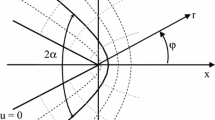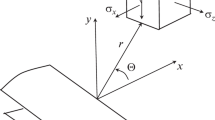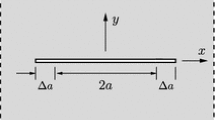Abstract
In this paper, we investigate the effects of non-singular stress (T-stress) on the mixed mode loading (I + II) near notch-tip field’s elastic compression-sensitive under plane stress and small scale yielding conditions. The crack path is estimated for three different shapes of notches using the Maximum Tangential Stress (MTS) approach. Constraint induced by the notch depth, shape of defaults and the notch-tip stress field in laboratory specimens is examined by Finite Element Analysis, and the effect of the deformation on modified (HRR) singularity stress field are discussed. The Volumetric Method (VM) criterion for compression and/or tension sensitive materials is described by a linear combination of the effective stress and the Notch Stress Intensity Factor. The results of our finite element computations based on a two-parameter fracture mechanics formulation show that the T stress has significant effects on the sizes, the shapes of the plastic zones and the crack path.
Access provided by CONRICYT-eBooks. Download conference paper PDF
Similar content being viewed by others
Keywords
1 Introduction
Recently, authors and research groups takes more discussed and observations an increasing number of papers, were working on the topic of characterization of crack tip stresses using more than one fracture mechanics parameter in mixed mode. Risk of mixed-mode fracture appears when a preexisting defect is load by a multiaxial loading or uniaxial load in a direction different to the normal direction to defect line. Prediction of this risk needs to answer to the following questions:
-
What is the fracture load knowing fracture toughness according to each elementary fracture mode?
-
What is the direction of fracture path?
-
For a blunt notch what is the facture initiation point?
For a crack likes defect, the problem of mixed mode of fracture has received a large attention. Several criteria are proposed in literature and can be classified in several families: local stress criteria, local strain energy density, equivalent notch stress intensity factor, local strain criteria, maximum energy release rate in local direction or local crack opening displacement criterion. A review of these different criteria is given in [1]. Validity of these criteria depends on fracture behavior of materials (brittle or ductile), level of mode mixity ratio \(M^{e}\) (predominant opening mode or not) and constraint.
When restricting our interest to brittle materials and low mode mixity ratio, the maximum tangential stress (MTS) criterion, originally proposed by Erdogan and Sih [2] and the strain energy density factor by Sih [3]. Mixed mode fracture emanating from notch has recently received increasing attention [4, 5]. El Minor et al. [6] have proposed an approach based on equivalent notch stress intensity factor. Ayatollahi et al. [7] have developed a criterion based on the maximum tangential stress (MTS) criterion. The critical tangential stress is expressed in terms of mode I and II notch stress intensity factors. Berto et al. [8] have proposed two fracture criteria and applied to blunt-notched components made of brittle materials loaded under mixed mode; the former is based on the averaged strain energy density over a given control volume, the latter on the cohesive crack zone model. These authors have studied brittle materials and received some success when using the maximum tangential stress (MTS) criterion and the strain energy density factor by Sih.
However for mixed mode of fracture emanating from notch, initiation point and influence of constraint needs particular attention. In mode I, fracture systematically initiates from the notch tip located on the notch bisector line; this is the point where the main principal stress is at a maximum, as well as the maximum shear stress and the strain energy density. Conversely, the point where fracture starts in mixed mode varies from case to case, because it depends on the geometry of the notch and loading mode mixicity ratio. Ayatollahi et al. [9] have taken into account the constraint in mixed mode of fracture emanating from notch by introducing the biaxiality ratio B and found that the mode mixicity ratio is affected by B.
Kim et al. [10] have shown that the biaxiality ratio B have some influence on bifurcation angle. This paper is focus on initiation point on fracture emanating from notch using MTS criterion. A comparison between U and V notches is made. Influence of T-stress on fracture load for Brazilian disc made in bio-ceramics is also study.
2 Material and Specimen
One of the key differences between metals and bioceramics is the “brittle” character of bioceramics. They may have to adapt to a deformation of more than a few microns. Unlike metals, bioceramics have no plasticity. They are characterized by a purely elastic behavior with a high Young’s modulus (Table 1) and until the failure stress is reached. Although bioceramics have a brittle fracture type, some of them can withstand very high compressive stresses, is the case of Zirconia, even if their total lack of plasticity does not allow them to accommodate deformation under the effect of stress concentrations. The study of compression behavior of bioceramics was performed on disk Brazilian loaded in mode I (β = 0°), mode II (β = 90°), and mixed mode (I + II). Two notches in V and U have been chosen. Dimensions are in millimeters, Fig. 1, for more details see Ref. [1]. The specimen thickness t is 4 mm and the values of length notch for U and V are 12 mm. Eleven different notch inclination θ = 10, 20, 30, 40, 50, 60, 70, 80 and 90°, were considered. Figure 2 represent some numerical results about Brazilian disk in compression loading (mixed mode). We present two types of notches: U and V in different angles from 0° (simple mode I) to 90° (simple mode II).
Two different materials are used, Aluminia and Zirconia. The specimens were loaded diametrically using a 100 kN capacity universal testing machine with a crosshead speed of 0.02 mm/min at ambient air. At first, loading was continued till failure at the different notch (U and V) and different inclination angle from (simple mode I) to simple mode II with respect to the loading direction to confirm a fracture load for each notch angle condition. Results of the maximum values of loading, for eatsh shape and inclination on the two specimens, are presented in the Table 2.
Isoperimetric triangular elements were used with six nodes with a dense network in the vicinity of notches. The same mesh style was retained for all samples of Alumina and Zirconia in mode I and mode I + II to eliminate any influence of change of the mesh on the results. The material is assumed to have a isotropic elastic behavior. The Brazilian disk, before and after loading, presented in Fig. 3a with red and blue color, respectively. Zoom of the affected zone are detailed in the Fig. 3b. The distributions of the principal stresses are given in the lines (L6 + L5) (see Fig. 3c).
Examples the tangential stress distributions for simple mode I (0°), simple mode II (90°) and mixed mode I-II (45°) are showed in Fig. 4. The tangential stress was formed along the notch line and was concentrated at the notch tip regardless of the notch inclination angle. Although the applied load for the pure mode I (212 N) was lessen than that for the mixed mode I + II (606 N), the tangential stress was much lower under the mixed mode I + II loading than the simple mode I loading. The simple mode II θ = 0° gives the higher values of loading for the two specimens with U and V notches.
3 Determination of Birfurcation Angle
The calculations of numerical results are based on the maximum tangential stress (MTS) criterion was first proposed by Erdogan and Sih [2] for brittle fracture in mixed mode I/II crack problems. This criterion will be extended to the notches problems. According to this, crack growth from notch, initiates radialy from the notch tip along the direction of maximum tangential stress \(\sigma_{\theta \theta ,\hbox{max} }\). The tangential stresses distribution along the contour (P6P7P8) are presented in the Fig. 5, for different angle, from pure mode I in compression (θ = 0°) to the simple mode II (θ = 90°). The contour (P6P7P8) is represented in radius. Figure 6 shows the principal stress distribution \(\sigma_{\theta \theta } ,\sigma_{rr}\) and \(\sigma_{\theta r}\) along of the contour (P6P7P8) for Aluminia specimen with U-notch. Important difference on the tangential stress is observed for inclination angles \(\theta\) and the two notches U and V. We assume that the mixed-mode (I + II) notch-initiated fracture is governed by the tangential stress (while \(\sigma_{\theta \theta }\) plays the major role in the cracking process).
Further, we have studied this stress distribution according to the maximum tangential stress direction.
In the Fig. 7, the determination of the point of the bifurcation are focus on the contour P 6 P 7 P 8 in the aim to identified and localized the condition of failure of structure emaning from U and V notches. The different situations of bifurcation are determined for the two materials Alumina and Zirconia for different orientation angle. The criterion assumes that in mixed-mode (I + II) fracture crack initiation from notches is governed.
By the tangential stress, is proposed, so called the Equivalent Notch Stress Intensity Factor, ENSIF. For the two materials with U and V notches shape, Alumina and zirconia, and inclination angles we have determined the maximum tangential stress points over the notch contour, Fig. 8a, b. The distributions of tangential stresses at the notch tip are analyzed according to this approach. The curves of maximum tangential stress distribution gives a minimum values in an orientation of θ = 20° for the U-notches and θ = 30° for the V-notches.
Figure 9a represent the numerical results of the maximum tangential stress for different orientation of loading \(\theta^{*}\) on the Aluminia Brazilian disk with V-notch, coupled with the bifurcation orientation \(\beta^{*}\). A sudden drop of the maximum tangential stress is noticed for a θ = 30°, orientation with the change in deviation propagation is taken from 90° to 0°.
The predicted directions of initial crack propagation are compared in Fig. 9b at the notch tip for U and V shape using the MTS fracture criteria. Numerical tests have shown that the series term has significant influence on the prediction of ini-tial crack propagation direction \(\beta^{*}\) with different shape of the notch. For the both shapes U and V notches, and in the margin of 0°–20°, they are deflected in the same way at the point P7. On the other side, when to move in the direction between 30°–60°, the U-shaped deflected quickly compared to the V shape. The two notches returns to point P7 guidelines that exceed 70°.
4 Determination of the Equivalent Notch Stress Intensity Factor
In the local mode I criterion, the magnitude of the elastic stress field can be described by a single parameter, \(K_{eq}\), designated the Equivalent Notch Stress Intensity factor, ENSIF. The applied stress, the crack shape, size, and orientation, and the structural configuration of structural components subjected to this type of deformation affect the value of the NSIF. This allows translating laboratory results directly into practical design information. The Equivalent Toughness, or the Equivalent Notch Stress Intensity Factor in mixed mode, ENSIF, is described and defines as a function of effective distance and effective stress given by relationship:
The ENSIF is considered as a value of facture toughness in the mixed mode, with units \({\text{MPa}}\sqrt {\text{m}}\), and the minimum effective distance corresponds to the abscissa of the upper limit of zone II and its distance from notch rot was suggested to be the effective distance \(X_{ef}\). It is a principle of fracture mechanics that unstable fracture occurs when the notch stress intensity factor at the notch tip reaches a critical value \(K_{\theta \theta }\). For the local mode I deformation and for small crack tip plastic deformation, i.e. plane strain conditions, the critical notch stress intensity factor for fracture instability is \(K_{eq,\rho ,c}\). The value \(K_{eq,\rho ,c}\) represents the fracture toughness of the material. A simple fracture criterion is obtained by using the critical notch stress intensity factor \(K_{eq,\rho ,c}\) and write:
The critical equivalent notch stress intensity factor is a facture toughness values with units \({\text{MPa}}\sqrt {\text{m}}\), if the notch has parallel side (notch angle equal to zero) and for elastic behaviour.
The tangential stress component value occurring along the notch-tip is plotted in Fig. 10 as a function of the distance \(r\). The inclined path is perpendicular to the notch-tip and starts from the point of the maximum of (P6P7P8) stress component along the notch profile. The finite element results are compared with the pure mode I (θ = 0°), pure mode II (θ = 90°) and mixed mode (I + II) (θ = 20°).
By definition, the effective tangential distance is the diameter of the process volume assuming it has a cylindrical shape. A typical example of the tangential stress distribution is presented in Fig. 11. The relative tangential stress has also been plotted versus distance r for Aluminia with U-notch at θ = 90°. All results for different notches and orientation of the two materials are recapitulated in the Table 2.
Figure 12a shows typical equivalent notch stress intensity factor curves for various notch inclination angles for Aluminia and Zirconia. The ENSIF values decreased as the notch inclination angle increased in the range of 0 < θ ≤ 20°. The Zirconia material gives the high values. The dependence of the fracture toughness on the notch inclination angle in the mixed mode loading condition can be understood by examining the stress distribution of notch tip formulated by Atkinson. For pure mode I θ = 0°, the maximum tangential stress is in tension but the shear stress tend to zero so that the crack propagates only under the influence of the tangential stress. However, for mixed mode I-II 0 < θ ≤ 20°, the shear stress increase with increasing on \(\theta\), take positive value with a maximum at around. θ = 20°, the tangential stress is decreasing and tend to minimum value on tensile. In this range, crack initiated from notch by the shear deformation at the notch tip might intensify the tangential stress so that the crack could be propagated at relatively low fracture toughness with increasing the notch inclination angle. Chandra Rao et al. [11] show, for modified compact tension specimen, the total fracture toughness remains more or less unchanged when the inclination of \(\theta\) increases from 0 to 30° and subsequently increases when \(\theta\) increases from 30 to 45°.
5 Conclusion
Mixed mode of fracture criteria predicts generally loading conditions of fracture and direction of bifurcation. In this paper, using the maximum tangential stress (MTS) criterion, in addition we are looking for position of fracture initiation emanating from notches. The criterion assumes crack initiation from notches is governed by the maximum tangential stress, introduced in the Equivalent Notch Stress Intensity Factor, ENSIF. This problem has been studied for the two ceramics (alumina and zircona) on Brazilian disks with U and V notches shape. Numerical results indicate that in fracture initiation location move by discrete values from center of the notch for low and high loading angle values to end of notch for intermediate values corresponding to some seldom experimental results in steel specimens. Evolution of computed equivalent notch stress intensity factor confirms existence of these three domains of fracture behavior with limits independent of notch geometry and material behavior.
References
Louah, M.: Fissuration en Fatigue en mode mixte I + II à l’aide du disque brésilien. Thèse de doctorat, Université de Metz (1986)
Erdogan, F., Sih, G.C.: On the crack extension in plates under plane loading and transverse shear. J. Basic Engng. Trans. ASME 85, 525–527 (1963)
Sih, G.C.: Strain-energy-density factor applied to mixed mode crack problems. Int. J. Fract. 10, 305–321 (1974)
Papadopoulos, G.A., Paniridis, P.I.: Crack initiation from blunt notches under biaxial loading. Eng. Fract. Mech. 31(1), 65–78 (1988)
Priel, E., Bussiba, A., Gilad, I., Yosibash, Z.: Mixed mode failure criteria for brittle elastic V-notched structure. Int. J. Fract. 144, 247–265 (2007)
El Minor, H., Louah, M., Azari, Z., Pluvinage, G., Kifani, A.: Brittle Mixed Mode Fracture I + II-Application of Equivalent Notch Stress Intensity Factor to the Cracks Emanating From Notches, Problems of strenght, No. 6, pp. 61–71. Décembre (2002)
Ayatollahi, M.R., Torabi, A.R.: Investigation of mixed mode brittle fracture in rounded-tip V-notched components. Eng. Fract. Mech.
Berto, F., Lazzarin, P., Gómez, F.J., Elices, M.: Mixed mode loading two procedures based on the equivalent local mode I concept. Int. J. Fract. 148, 415–433 (2007)
Smith, D.J., Ayatollahi, M.R., Pavier, M.J.: The role of T-stress in brittle fracture for linear elastic materials under mixed-mode loading. Fatigue Fract. Eng. Mater. Struct. 24, 137–150 (2001)
Kim, J.H., Paulino, G.H.: T-stress, mixed mode stress intensity factors and crack initiation angles in functionally graded materials: a unified approach using the interaction integral method. Comp. Meth. Appl. Mech. Eng. 192, 1463–1494 (2003)
Chandra Rao, B.S.S., et al.: Mater. Sci. Eng. A476, 162–168 (2008)
Author information
Authors and Affiliations
Corresponding author
Editor information
Editors and Affiliations
Rights and permissions
Copyright information
© 2017 Springer International Publishing Switzerland
About this paper
Cite this paper
Hadj Meliani, M., Bouledroua, O., Ould-M’beirick, M., Elmiloudi, K., Sadou, M., Pluvinage, G. (2017). Crack Path Stabilisation and T-Stress Estimation in Connection with the Global Approach for Inclined Notches. In: Boukharouba, T., Pluvinage, G., Azouaoui, K. (eds) Applied Mechanics, Behavior of Materials, and Engineering Systems. Lecture Notes in Mechanical Engineering. Springer, Cham. https://doi.org/10.1007/978-3-319-41468-3_8
Download citation
DOI: https://doi.org/10.1007/978-3-319-41468-3_8
Published:
Publisher Name: Springer, Cham
Print ISBN: 978-3-319-41467-6
Online ISBN: 978-3-319-41468-3
eBook Packages: EngineeringEngineering (R0)
















